- Details
- Written by Gordon Prentice
The oldest tree in Newmarket is in the back yard of a house at 438 Botsford Street but it may not be with us much longer. 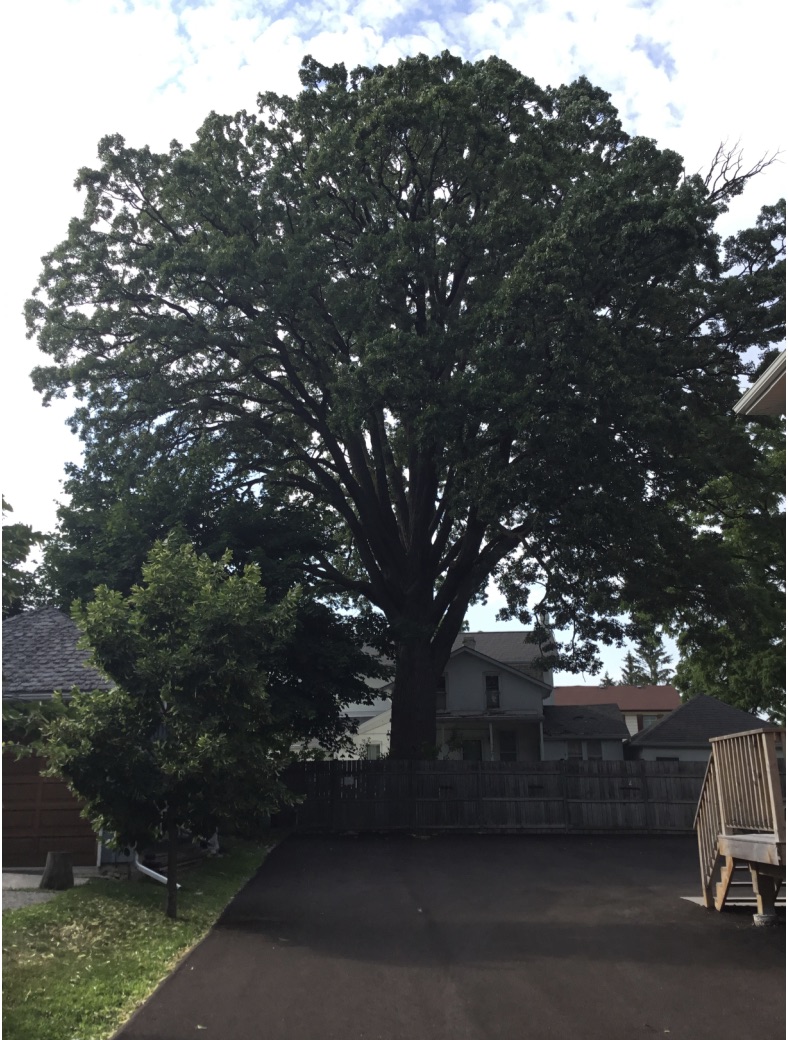
The old White Oak was designated as a heritage tree in 2005 and is at least 214 years old, possibly as much as 314 years old. It is huge.
Think about it. Astonishingly, it was there during the Battle of Trafalgar in 1805.
And the old tree was standing during the Rebellion of 1837. It is a fabled part of our Town’s history.
438 Botsford Street (or Liberty Hall) was the home of James B. Caldwell, a rebel sympathiser. The tree became known as Liberty Tree.
"They paved paradise and put up a parking lot"
It sits smack bang up against the property line with a neighbouring house on Timothy Street whose owners, despite the tree’s heritage designation, paved over the entire back yard to provide additional parking for their new apartment building. About 35% of the tree’s root system is buried under 8 inches of impervious asphalt.
As a result, the old tree could be starved of the vital nutrients it needs. It doesn’t get the constant drip of nourishing rainwater. And construction of the Timothy Street building saw huge piles of earth being heaped on top of the tree’s root system by heavy construction equipment. Fifty per cent of a tree’s root system is in the top one foot of soil and 90% is in the top three feet. Heavy machinery can do real damage but it is hidden and can take years to manifest. For the moment, the tree looks good for its great age but that could change overnight.
"It's a piece of our history"
Victor Woodhouse was on the Council back in 2007 when the Council was considering making a $750 grant “to invest in the well-being of the tree”. At the time he said:
“It is the only designated tree in Town. This is a piece of our history. It’s too bad it’s not more visible to the public so everyone could enjoy it.”
So, what needs to be done? The Town should immediately commission an expert arborist to check the tree for signs of distress and to report on its overall condition. If the paving has to be dug up to save the tree then that should happen. No question.
But how was it possible for the Liberty Tree’s root system to be paved over, apparently without a second thought?
Who is policing the Town’s designated heritage properties and its other features of historic value?
Trees need us
The Town is currently looking at its policies on trees and not before time. For years, developers have been buying up and clear-cutting building lots before putting in applications to the Town to demolish old houses and redeveloping with much bigger ones. Profit is the priority and trees get in the way.
That mind-set needs to change. Trees need us. And we need them.
What a terrible indictment of the Town of Newmarket and its stewardship if, by inaction, indifference or neglect, it allows the old Liberty Tree to wither and die, its roots suffocating under a parking lot.
This email address is being protected from spambots. You need JavaScript enabled to view it.
Update on 16 August 2019: And here is how Newmarket Today covered the story.

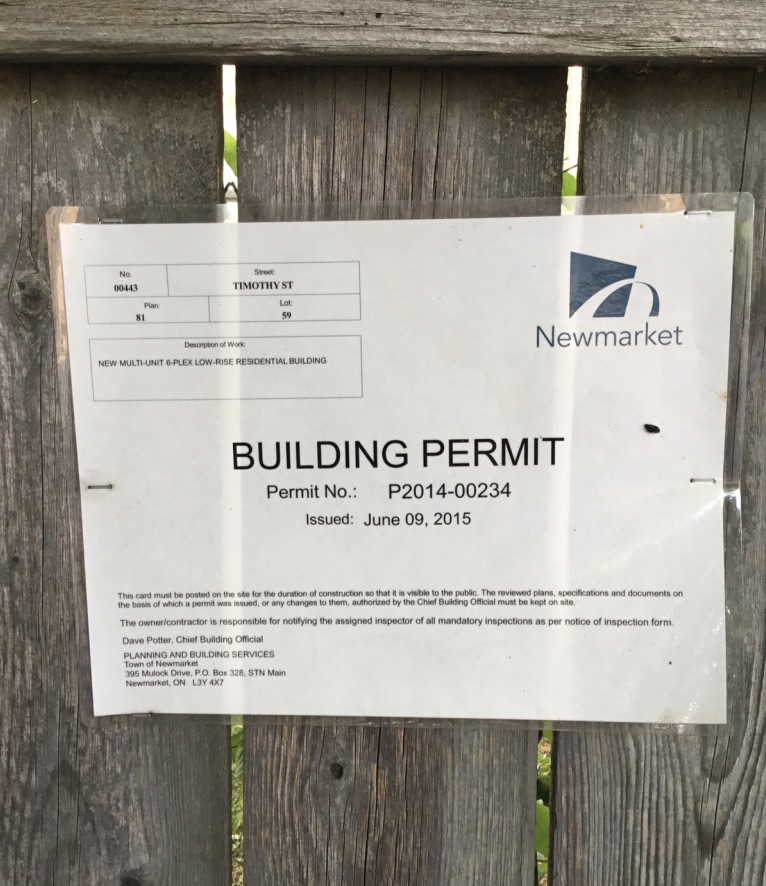
- Details
- Written by Gordon Prentice
Earlier this afternoon I received this curious email from Conrad Black or someone purporting to be Conrad Black. The email address is shown as This email address is being protected from spambots. You need JavaScript enabled to view it.. 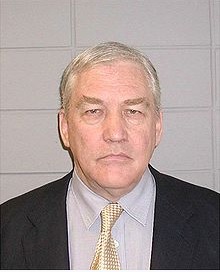
Baron Black of Crossharbour takes issue with an earlier post of mine in which I describe him as a convicted fraudster:
“Mr. Prentice, my media office has sent me your reference to me as “convicted fraudster” in a recent internet piece. The fraud in question was vacated by the U.S. Supreme Court unanimously and spuriously retrieved by the lower court to which the vacated counts were remanded for “assessment of the gravity of (the lower court’s) errors.”
The charge consisted of the receipt of $285,000 that had been approved by the independent directors, posted in the company’s public filings, and was deemed (correctly) by the trial judge to be a clerical error of a co-defendant.
Finally, this count also was “expunged,” that is to say I have now officially never been charged in the U.S.
The reason publicly given for this was not an ex gratia act of mercy and clemency by the president; it was on the recommendation of the White House counsel office after thorough research that I should never have been charged and that no crime was committed. Your reference was defamatory.
As I doubt that you have enough readers or measurable influence to do me any damage, I don’t believe that if I sued you, while I would certainly gain a judgment that you have defamed me, I would receive a damage award adequate to cover my legal expenses.
But this will serve as your notice that if you continue to describe me in those or similar terms-not calling me a jerk or a horse’s ass or anything like that, which would be a matter of opinion and fair comment, but as a criminal whose principal descriptive characteristic is the commission of frauds of which I have been convicted, I will be able to demonstrate intent to defame, which bears serious consequences even if you are only read by ten people.
In that event, I will not be so forebearant. I did win the greatest libel settlement in Canadian history ($5 million) from the authors of the infamous special committee report of 2004. This is the only cautionary notice you will receive. Conrad Black”
Delicious!
This email address is being protected from spambots. You need JavaScript enabled to view it.
Update at 18.00 on 24 July 2019: Can I continue to describe Baron Black of Crossharbour as a “convicted fraudster”? I believe I can but I’ve got to tread carefully. Lord Black has pots of money to hire fancy dancing lawyers and I’ve got Wikipedia. 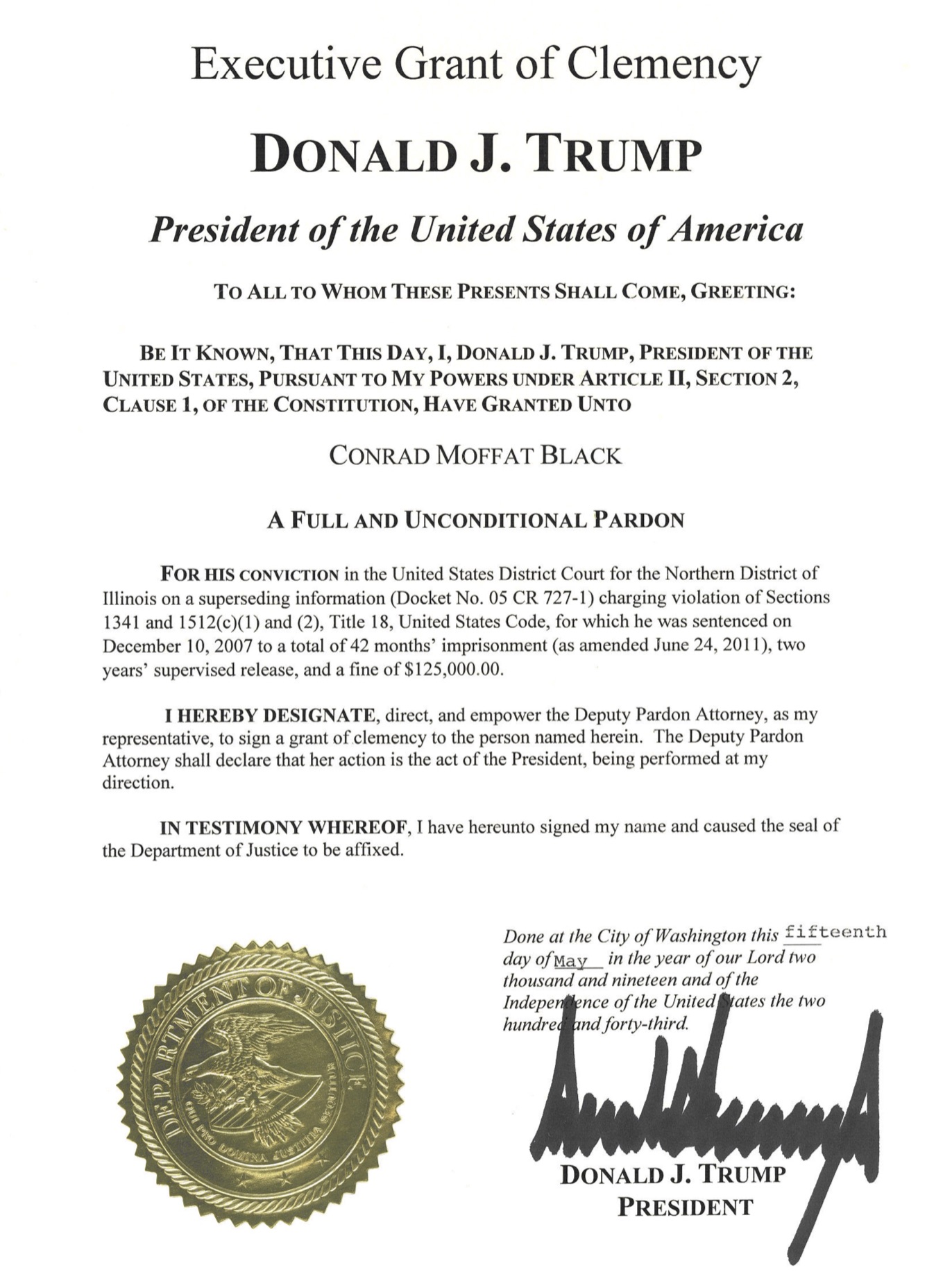
The noble Lord tells me the conviction for the “receipt of $285,000” was “expunged” by the President:
“on the recommendation of the White House counsel office after thorough research that I should never have been charged and that no crime was commited”.
The Office of the Pardon Attorney (in the US Department of Justice website) addresses this question:
"Does a presidential pardon expunge or erase the conviction for which the pardon was granted?"
And gives this answer:
"No. Expungement is a judicial remedy that is rarely granted by the court and cannot be granted within the Department of Justice or by the President. Please also be aware that if you were to be granted a presidential pardon, the pardoned offense would not be removed from your criminal record. Instead, both the federal conviction as well as the pardon would both appear on your record. However, a pardon will facilitate removal of legal disabilities imposed because of the conviction, and should lessen to some extent the stigma arising from the conviction…"
That’s seems clear enough. Expungement cannot be granted by the President but only by a Court of Law and the White House Counsel’s Office is not, of course, a Court of Law.
A presidential pardon – an Executive Act of Clemency - would not remove a pardoned offense from a criminal record.
So how does his Lordship figure that I am defaming him when I refer to him as a “convicted fraudster”?
Isn't that what he is?
Update at 18.00 on 25 July 2019: The following exchanges took place with His Lordship
Me (Jul 25, 2019, at 12:14 PM)
Thank you for your email of yesterday’s date in which you warn me not to refer to you as a convicted fraudster. You say I have defamed you.
You mention expungement which followed a recommendation from the White House Counsel’s Office.
I am told expungement cannot be granted by the President only by a Court of Law. Furthermore a Presidential Pardon does not remove the pardoned offence from the criminal record.
The two lie alongside each other so to speak, the pardon and the original offence.
Am I wrong about this? If so, in what way?
Lord Black of Crossharbour (Jul 25, 2019, at 12:39 PM):
You are mistaken. Officially, I was never charged.
Me (July 25, 2019 at 1:03PM)
In what way am I mistaken? How is it possible to be convicted of an offence without being charged first with that offence?
And what do your mean by “officially” when you tell me that “Officially, I was never charged”?
Please be as clear as possible so I can fully understand the argument and your reasoning.
Me (July 25, 2019 at 2.32PM)
I have been reflecting on our earlier exchanges.
It would aid my understanding if you would let me have sight of the report from the White House Counsel’s Office on which you rely and which said you should never have been charged and that no crime was committed.
Will you please send it on to me?
Lord Black of Crossharbour: (2.51PM)
No
Update on 23 December 2020: From the New York Times. The editorial on Trump's pardons.
Update on 25 December 2020: From the National Post: Trump Pardons Hollinger Executives with the support of Lord Black.
Update on 14 January 2021: From Bob Hepburn in the Toronto Star: Conrad Black's loud and sad fawning over Trump.
- Details
- Written by Gordon Prentice
The convicted fraudster, Conrad Black, has been rooting for Boris Johnson in the latter’s quest to become Britain’s next Prime Minister. It is easy to see why. They both display a casual disregard for the truth. 
Earlier today Johnson won the Conservative leadership with 66% of the votes on a 87.4% turnout – 92,153 to Jeremy Hunt’s 46,656. So Johnson becomes PM on Wednesday after his visit to the Palace, voted into office by a tiny unrepresentative sub-set of the British population.
The shrivelled membership of the Conservative Party (with only 159,320 members) looks quite unlike contemporary Britain - it is older, wealthier and whiter – but they like Boris who makes them laugh and feel good about themselves. And they are prepared to overlook his many negative qualities.
More bluster than achievement
After following the antics of Donald Trump for years, the New York Times knows a liar when it sees one. It describes Johnson today in these terms:
“A rumpled master of political theater and the quotable quip, he is idolized by rank-and-file Tories determined to quit the European Union no matter what the consequences. Yet his record as journalist, legislator, London mayor and foreign secretary displays far more bluster than achievement, and a consistent disdain for hard work, probity or the truth.”
Johnson routinely makes false claims. When he was European Correspondent of the Daily Telegraph he invented stories about the EU which, astonishingly, were taken at face value by credulous Conservative voters back home in Britain. He told them, for example, the EU wanted to standardise the size of coffins and condoms and they lapped up this drivel.
The winning formula that brought him success as a journalist was all laughter and lies.
Horrible to behold
Half a lifetime ago when Johnson was editing The Spectator and I was a humble backbench Member of Parliament he called me out of the blue to quiz me on my views on fox hunting (which were then very well known). I was very much in favour of a ban on hunting with hounds and played a modest part in getting the law changed. In the profile which subsequently appeared Johnson observed: 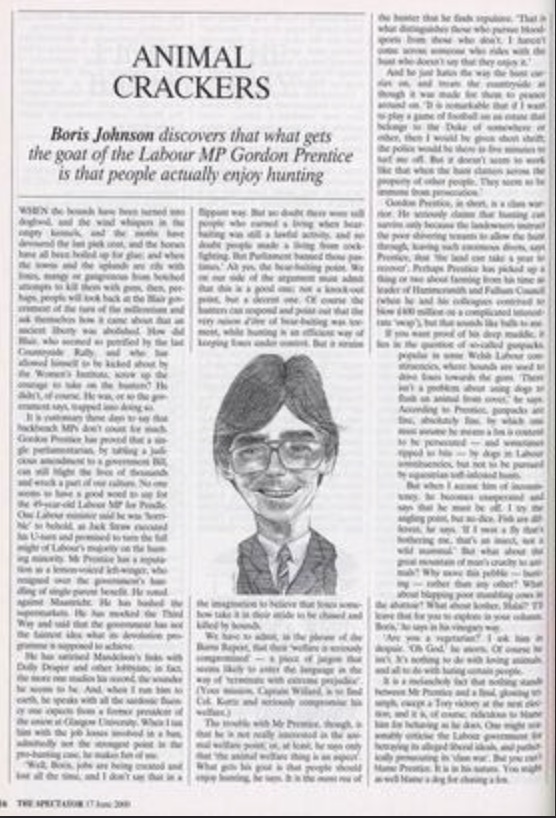
“It is customary these days to say that backbench MPs don’t count for much. Gordon Prentice has proved that a single Parliamentarian, by tabling a judicious amendment to a Government Bill, can still wreck a part of our culture.”
I was quite happy with that but then he goes and spoils it all by quoting an unnamed Labour minister who apparently says I am “horrible to behold” and that no-one has a good word to say about me.
Oh dear!
Now that he is Prime Minister, Johnson’s promises will collide with reality. Writing in Sunday’s Observer Andrew Rawnsley reminds us that at various times Johnson promised (a) to leave the EU without a deal on October 31 if the EU refuses to renegotiate Theresa May’s Withdrawal Agreement (b) not to have a General Election before Brexit is done and (c) no further referendum. Rawnslay says:
“At least one of those pledges cannot be kept. When it has to be broken, I’d quite like to see the look on Theresa May’s face.”
"Utterly unfit to be Prime Minister"
Boris Johnson’s former boss at the Daily Telegraph Max Hastings, tells us he is “utterly unfit to be Prime Minister”.
“Johnson would not recognise truth, whether about his private or political life, if confronted by it in an identity parade. In a commonplace book the other day, I came across an observation made in 1750 by a contemporary savant, Bishop Berkeley: “It is impossible that a man who is false to his friends and neighbours should be true to the public.” Almost the only people who think Johnson a nice guy are those who do not know him.”
Conrad Black, who was the proprietor of the Daily Telegraph and The Spectator from 1985-2004, last month sprang to Johnson’s defence. In a piece in the Spectator Black brands Hastings a coward:
“Max Hastings vs Boris Johnson: I know who I’d trust more”
“(Boris Johnson) had his lapses, but he was capable, successful and reliable when it counted, and he is, as he appears, a pleasant man. Max is an ill-tempered snob with a short attention span. He has his talents, but it pains me to report that when seriously tested, he was a coward and a flake. I think Boris will be fine.”
Donald Trump agrees.
With endorsements such as these how can Boris fail?
This email address is being protected from spambots. You need JavaScript enabled to view it.
Update at 18.20: And this is how the Guardian views the Johnson Premiership.
- Details
- Written by Gordon Prentice
Tonight (Monday 8 July 2019) is a big occasion for Tony Van Bynen - and for members of the Liberal Party in Newmarket-Aurora.
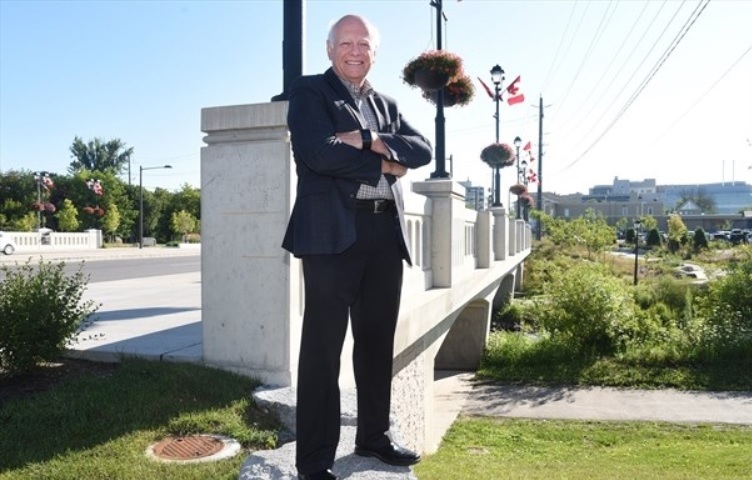
The 68 year-old Van Bynen who has spent 18 years in municipal politics being “steadfastly bipartisan” is being acclaimed at 7.30pm at the Royal Canadian Legion in Newmarket’s Srigley Street as the new Liberal candidate for the October Federal Election.
Van Bynen will address hundreds of Liberal Party activists expecting to be fired-up and motivated for the campaign ahead.
Van Bynen will not let them down. He has spent a lifetime preparing for this moment.
What will he say? Will he invite questions? Will the hat be passed around to help fill his campaign war chest?
Inspiration
He will tell his audience he draws inspiration from three famous leaders – the Dalai Lama, Martin Luther King and John A. Macdonald.
The Dalai Lama has certainly made his mark on the old banker. For years I have witnessed him at York Regional Council, head slightly bowed, deep in meditation, saying nothing.
And then there’s Martin Luther King whom Van Bynen admires for his social justice. We shall find out tonight whether Van Bynen's concern for social justice goes beyond mere neighbourliness which has been, until now, the defining core of his political beliefs.
Van Bynen also looks for inspiration to John A. Macdonald, praising the man’s vision and commitment to build. At a time when Justin Trudeau is trying hard to put relations with Canada’s First Nations on a sounder and less contentious footing, the old banker’s choice of Macdonald (who believed in the forced assimilation of indigenous peoples) may seem misjudged.
Priorities
But in any event, this is Van Bynen’s big opportunity to throw his natural banker’s caution to the winds and tell us what he really thinks about the challenges facing Canada. When he gets to Ottawa what will be his priorities?
Will we hear a call to arms or get one of those bland re-heated offerings that he used to dish out year-after-year to the local Chamber of Commerce, telling them how terrific Newmarket is? No. I think we can expect a rousing speech which sends shivers up the spine.
Van Bynen will want to speak out clearly and unequivocally about the things in Canada that need to change. If he sees injustice I expect him to shout about it, not look the other way.
This may be a tall order for a man who is happiest when dealing in woolly generalities, who rarely stakes out a position on controversial subjects unless he is absolutely forced into a corner. He tells us this is his golden rule:
“We need to listen to all perspectives”.
Pensions a priority? (other than his own)
How would that have worked when Sears Canada closed its doors at Upper Canada Mall? When the local Sears was selling off its stock at knockdown prices I recall conversations with Sears staff whose pensions were disappearing before their eyes. Whose side would the Voice for Fiscal Prudence have been on? And when he gets to Ottawa what will he do about it?
Van Bynen will talk about climate change but I doubt he will use the term “climate crisis” or even “climate emergency”. Even though Canada is warming twice as fast as the rest of the planet, that would probably be a step too far. He says:
“Climate change is very real and the Conservatives are pretending it is not a serious issue.”
Tonight he will laud the various initiatives taken at Newmarket Council such as solar panels and Soofa benches. But he won’t mention the York Regional Climate Change Action Plan. He chose not to comment when it came up for ratification on 16 November 2017. He missed the previous meeting when it was considered it detail (and that's OK) but was silent at full Council when he could have spoken. But that's entirely typical.
Follow the leader
We can thank the old banker’s long-time colleague, former councilor Dave Kerwin, for reminding us that Van Bynen is not a leader. It is best to think of him as a well-paid administrator. The old banker came up with this little gem in 2016:
“Leadership is as much about followership.”
I think he means we are all joined in a common pursuit, a common endeavour, the leaders and led. He just gets more money than the led.
When it is all over and Tony Van Bynen MP is comfortably settled in his new office in Ottawa, gazing out over the river, daydreaming, will he still block me from reading his tweets, as he does now?
Probably.
This email address is being protected from spambots. You need JavaScript enabled to view it.
Van Bynen told City Life Magazine his inspiration comes from “three famous leaders”
“I very much admire the Dalai Lama, because of his way of listening. Martin Luther King Jr. is someone whom I admire for his social justice. And when I think of John A. Macdonald, I think about the man’s vision on commitment and how to build.”
Update on 9 July 2019: And this is how Newmarket Today covered the meeting.
- Details
- Written by Gordon Prentice
The Federal Election on 21 October 2019 will be the second on the new riding boundaries for Newmarket-Aurora which were established in 2013. Before then the riding encompassed the two towns but now the southern boundary is at Wellington Street, severing Aurora, and the northern one is at Green Lane in East Gwillimbury. 
It is more prosperous than the average Canadian riding and leans Conservative.
Check the 2016 Census for Newmarket here and Aurora here. And to put it all in context here is an infographic from Statistics Canada showing income for Canadians in 2017. And the latest Canadian income survey is here.
The candidates
So far we have four candidates in the field. The sitting MPP, Liberal Kyle Peterson, is standing down after one term and the new Liberal standard-bearing is ex-banker Tony Van Bynen, twenty years his senior. The Conservatives are running the 64 year old re-tread Lois Brown who represented the riding from 2008-2015.
The NDP is once again putting its faith in Yvonne Kelly who ran a spirited campaign in 2015 but came third. She is an acknowledged expert in key social policy fields, chairing Ontario’s Social Planning Network and co-chairing the Social Planning Council of York Region.
The affable Walter Bauer, a professional engineer and expert witness, represents the Green Party. He ran unsuccessfully in Richmond Hill in last year’s Provincial election. He is often seen outside Christine Elliott’s constituency office on Fridays taking part in the regular protests about the Provincial Government’s cutbacks.
Maxime Bernier’s People’s Party of Canada has yet to select a candidate but is expected to do so. The irrepressible Dorian Baxter is also expected to throw his hat into the ring.
Odds on a Conservative win
The website 338Canada.com puts the odds of the Progressive Conservatives winning Newmarket-Aurora at 69% and the Liberals 31%. The website electionprediction.org whose evaluations are "entirely subjective" gives the seat to the Conservatives.
But who knows? The Liberals have a strong and resilient brand which could mask the obvious flaws of their standard-bearer, Tony Van Bynen, who is coming out of a comfortable retirement after being (in his own words) "steadfastly bipartisan" throughout his 18 years in municipal politics.
It is undeniably the case that the Conservatives are not polling as strongly in Ontario as elsewhere. This is likely to be the Ford factor at work. Buck-a-Beer is uniquely unpopular here. The latest polling averages in Ontario put the Liberals on 36.9% and the Conservatives trailing at 32.7%.
The old duopoly
Of course, it is not simply a choice between the Conservatives and the Liberals, the old duopoly. The Greens are polling well. And we shall see if, against all the pundits’ expectations, the NDP can get traction.
The key, as always, is persuading people to vote. In the Federal Election in Newmarket-Aurora in 2015 there were 83,351 electors. Turnout was 68.1% - just higher than the Ontario average of 67.8%.
This email address is being protected from spambots. You need JavaScript enabled to view it.
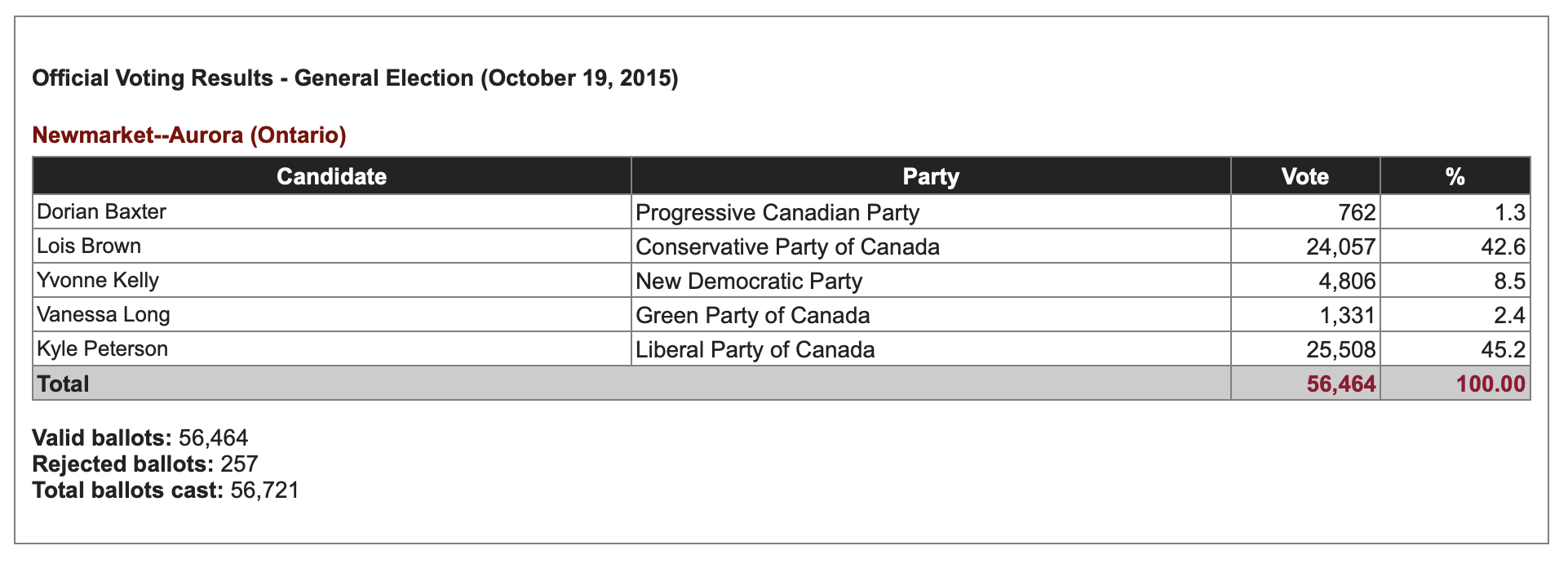
Page 122 of 286